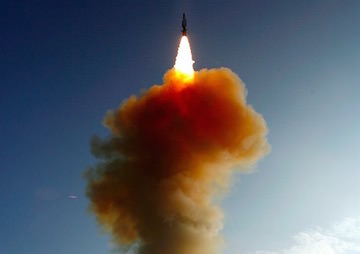China, Russia and the U.S. May Be Gearing Up for War in Space
While the prospect of war in space is hardly new (think Reagan-era "Star Wars"), the three powers are known to be developing and testing controversial new capabilities with terrifying implications -- despite their denial of such work. An anti-satellite missile test. According to Scientifc American, tests "like this one conducted by the U.S. Navy in February 2008, are part of a worrisome march toward military conflict in outer space." (U.S. Navy / CC BY-SA 3.0)
An anti-satellite missile test. According to Scientifc American, tests "like this one conducted by the U.S. Navy in February 2008, are part of a worrisome march toward military conflict in outer space." (U.S. Navy / CC BY-SA 3.0)
“As China and Russia aggressively seek to challenge U.S. superiority in space with ambitious military space programs of their own,” Scientific American tells us, “the power struggle risks sparking a conflict that could cripple the entire planet’s space-based infrastructure. And though it might begin in space, such a conflict could easily ignite full-blown war on Earth.”
While the prospect of war in space is hardly new (think Reagan-era “Star Wars”), the three powers are known to be developing and testing controversial new capabilities with terrifying implications — despite their denial of such work.
The article explains:
The long-simmering tensions are now approaching a boiling point due to several events, including recent and ongoing tests of possible anti-satellite weapons by China and Russia, as well as last month’s failure of tension-easing talks at the United Nations.
Testifying before Congress earlier this year, Director of National Intelligence James Clapper echoed the concerns held by many senior government officials about the growing threat to U.S. satellites, saying that China and Russia are both “developing capabilities to deny access in a conflict,” such as those that might erupt over China’s military activities in the South China Sea or Russia’s in Ukraine. China in particular, Clapper said, has demonstrated “the need to interfere with, damage and destroy” U.S. satellites, referring to a series of Chinese anti-satellite missile tests that began in 2007.
There are many ways to disable or destroy satellites beyond provocatively blowing them up with missiles. A spacecraft could simply approach a satellite and spray paint over its optics, or manually snap off its communications antennas, or destabilize its orbit. Lasers can be used to temporarily disable or permanently damage a satellite’s components, particularly its delicate sensors, and radio or microwaves can jam or hijack transmissions to or from ground controllers.
In response to these possible threats, the Obama administration has budgeted at least $5 billion to be spent over the next five years to enhance both the defensive and offensive capabilities of the U.S. military space program. The U.S. is also attempting to tackle the problem through diplomacy, although with minimal success; in late July at the United Nations, long-awaited discussions stalled on a European Union-drafted code of conduct for spacefaring nations due to opposition from Russia, China and several other countries including Brazil, India, South Africa and Iran. The failure has placed diplomatic solutions for the growing threat in limbo, likely leading to years of further debate within the UN’s General Assembly.
“The bottom line is the United States does not want conflict in outer space,” says Frank Rose, assistant secretary of state for arms control, verification and compliance, who has led American diplomatic efforts to prevent a space arms race. The U.S., he says, is willing to work with Russia and China to keep space secure. “But let me make it very clear: we will defend our space assets if attacked.
Read the full article here.
–Posted by Roisin Davis
Your support matters…Independent journalism is under threat and overshadowed by heavily funded mainstream media.
You can help level the playing field. Become a member.
Your tax-deductible contribution keeps us digging beneath the headlines to give you thought-provoking, investigative reporting and analysis that unearths what's really happening- without compromise.
Give today to support our courageous, independent journalists.









You need to be a supporter to comment.
There are currently no responses to this article.
Be the first to respond.